Learn to love the charm of petite annual blooms! These little blossoms are delicate yet resilient, adding pleasure to any garden. They are low care and have brilliant colors, making them ideal for pots, borders, and ground cover. See our list of the best 25 types of small flowers for your garden – ideal for both novice and expert gardeners.
The most beautiful small flowers in the world
1. Queen Anne’s Lace (Daucus carota)
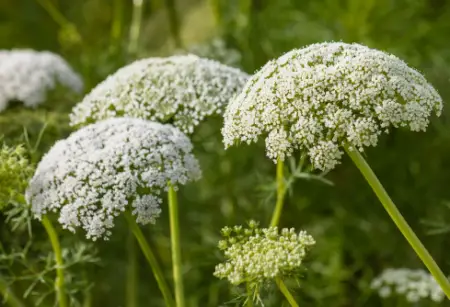
Daucus carota, commonly known as Queen Anne’s Lace, is a lovely plant that frequently emerges from forgotten carrot tops. With delicate white flowers and a dramatic deep purple floret, its slender stems can grow up to seven feet in height. It is a charming addition to wildflower gardens, but its quick self-seeding gives it a bad reputation as a weed. Regular removal of wilted flowers can help limit their spread. This hardy plant likes full or partial sunlight and well-draining soil. It grows well in USDA Growing Zones 3–10. It usually grows to a height of 6 to 7 feet and is resistant to deer.
2. Stonecrop (Sedum)
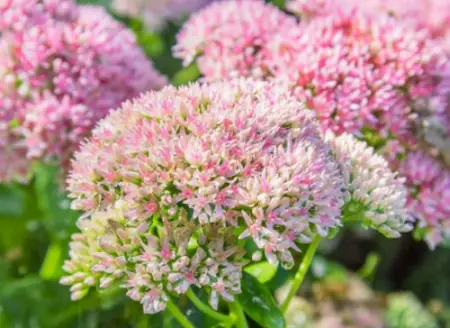
Stonecrop, or sedum, is a well-liked succulent that draws bees. They have approximately 600 varieties, ranging in height from short to tall and erect, and they bloom late with little, colorful flowers shaped like stars. They are perfect for ground coverings, containers, and edging because of their eye-catching foliage.
These plants, which are available in red, pink, yellow, and white types, flourish in USDA Growing Zones 3–10. They can grow to a height of 6 to 24 inches and prefer sandy or loamy soil that drains well. Although they don’t always withstand deer, they usually provide gardeners with a simple, eye-catching alternative.
3. Heather (Calluna vulgaris)
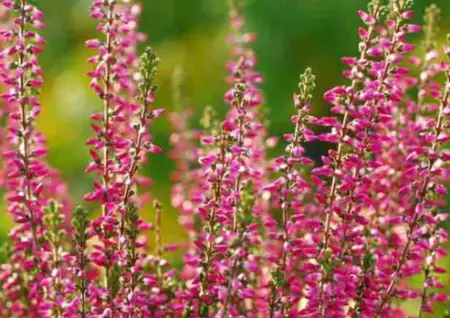
Tiny, evergreen leaves contrast attractively with mauve, purple, or white flowers that blossom gently from midsummer to early fall on the woodsy Heather (Calluna vulgaris). It spreads rapidly in some marshy places, such as North Carolina, Massachusetts, and Rhode Island, and thrives in damp, acidic conditions akin to those found in Scotland’s heathlands.
Growing Zones 4-6 are ideal for Heather, which may grow up to 24 inches tall and needs sandy, damp soil. It is a sturdy and attractive option for a variety of garden settings because it is notably resistant to deer.
4. Yarrow (Achillea millefolium)
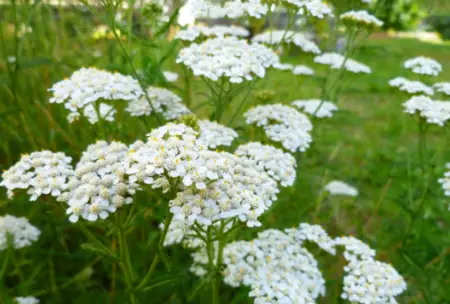
Yarrow, or Achillea millefolium, is a hardy perennial plant that spreads quickly thanks to its flat, small flower clusters. Deadheading the flowers and stopping seed dissemination are advised in order to regulate its growth. Yarrow’s pollen-rich blossoms draw bees, butterflies, and other pollinators, and it usually blooms from summer through fall. Once established, it can withstand extreme droughts with extraordinary resilience.
Yarrow is a versatile plant that grows well in USDA Growing Zones 3–9. It comes in a variety of hues, including purple, white, yellow, pink, orange, red, and bi-colored variations. It grows to a mature height of two to three feet, flourishing in full sun exposure and well-drained soil. What’s more, it is resistant to deer, which makes it a great choice for gardens looking for hardy, low-care plants.
5. Lantana (Lantana camara)
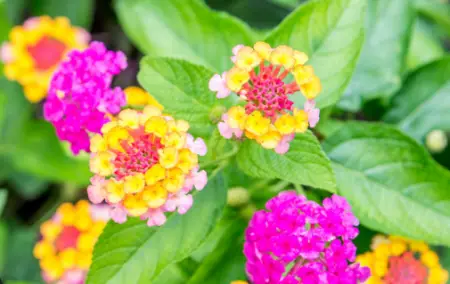
A vivid summer blooming, Lantana (Lantana camara) adorns gardens with clusters of tiny, vividly colored blooms ranging from pink and blue to purple, yellow, orange, white, red, and even bi-colored. The garden’s charm is increased by these blooms, which are known to draw hummingbirds and butterflies.
The tough, citrus-scented leaves of lantana discourage deer from approaching. Resilient in USDA Growing Zones 7 through 11, it thrives best in full sun and well-draining soil. It can be grown as an annual in colder climates. Notably, lantana can spread to other parts of the United States that are warmer, like Florida, Hawaii, and Arizona. Reaching a mature height of six feet, it’s a great option for gardens looking for colorful, low-maintenance plants.
6. Butterfly Weed (Asclepias tuberosa)
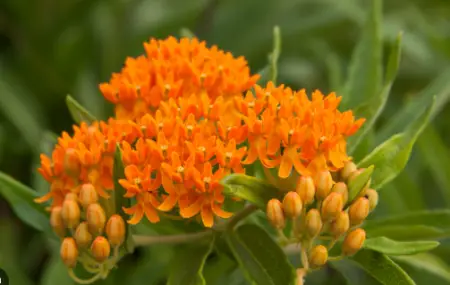
Asclepias tuberosa, sometimes known as Butterfly Weed, is a popular choice for bees and butterflies. It has clusters of tiny, bright orange or yellowish flowers that bloom profusely in the summer. This plant thrives in full sun and shows remarkable resistance to drought. Aphids may find it quite appealing, even though deer and rabbits don’t seem to be drawn to it. Aphids are a major food source for monarch butterflies, thus it’s best to deal with them without using pesticides.
Butterfly Weed is native to USDA Growing Zones 3 through 9, and it thrives in dry, well-drained soil. It appears in vivid orange and yellow varieties. Mature heights of one to two feet make it a great choice for gardeners who want to draw pollinators but also keep the area resistant to deer.
7. Lavender (Lavendula spp.)
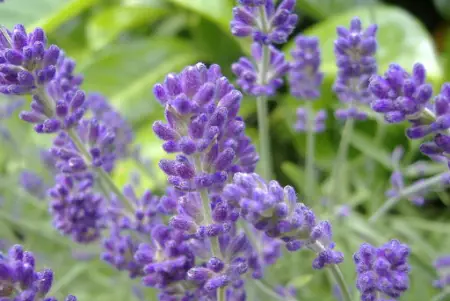
Renowned for its delicate and fragrant purple blooms that are sparingly distributed on spikes, lavender (Lavendula spp.) is a perennial herb. This plant thrives in full sun and shows remarkable resistance to drought. Allowing the plant to dry out before watering it is a crucial technique for promoting bloom development. It grows at a modest rate, usually gaining a few inches in size year.
Mostly seen in purple hues, lavender is suited for USDA Growing Zones 5 through 9 and thrives in soil that is dry and well-draining. It’s a great choice for gardens looking for a low-maintenance, deer-resistant plant with aromatic appeal, as it reaches a mature height of two to three feet.
8. Butterfly Bush (Buddleja davidii)
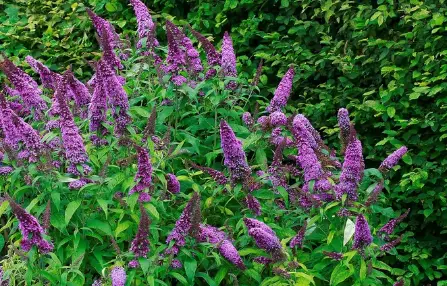
The growth pattern of Butterfly Bush (Buddleja davidii) varies; some cultivars can grow as tall as 12 feet, while others stay smaller, at about 3 feet. It displays gorgeous sprays or clusters of little flowers in an array of hues during the summer. This plant, which grows best in full sun, tends to self-seed and can soon take over a space if it is not controlled. The butterfly bush is deciduous in warmer climates, losing its leaves in the spring; in colder climates, however, it grows again from the ground up.
The Butterfly Bush comes in a variety of colors, including purple, pink, blue, white, and yellow, and is suitable for USDA Growing Zones 5 through 9. It grows well in soil that is moist and drains properly, reaching a mature height of three to twelve feet. It is a well-liked option for gardeners looking for colorful, low-maintenance plants because of its notable resistance to deer.
9. Primrose (Primula spp.)
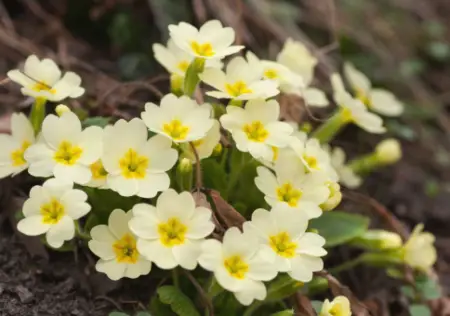
In spring, Primroses bloom vibrantly on robust stalks; some types have multiple flowers in a cluster on a single stem, while others have a single flower per stalk. Although they may withstand full sun if they receive regular care, these perennials prefer partial sun. Dividing them on a regular basis aids in managing their growth.
Except for Zones 9 and upwards, where they suffer without colder temperatures, they can be annuals in all USDA Growing Zones except those where they flourish, which are Zones 3 through 8. They grow well in moist, well-drained soil and can be found in a variety of hues, including red, pink, orange, yellow, blue, purple, and white. When fully grown, they normally measure 6 to 20 inches in length. They are a desirable choice for colorful, low-maintenance gardens because they are also resistant to deer.
10. Egyptian Star Clusters (Pentas lanceolata)
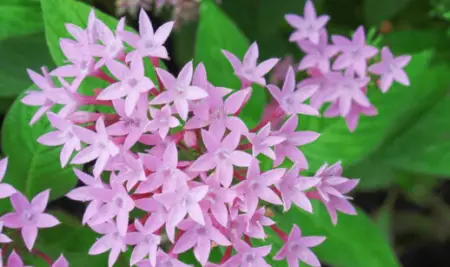
Pentas, or Egyptian Star Clusters, are 4-inch clusters of nectar-rich, five-pointed star-shaped flowers that attract hummingbirds, butterflies, and bees. These clusters display vivid colours of red, pink, and purple as they bloom consistently for a long time. Although it is mostly an annual, it also grows as a perennial in warmer zones, such Zone 10. The plant’s flowering season can be prolonged with regular deadheading.
Egyptian Star Clusters, which are hardy in USDA Growing Zones 10–11, favor either full or partial sun exposure and flourish in rich, well-draining soil. Mature plants reach a mature size of 24 to 36 inches, and they also show deer resistance, which makes them a great choice for gardens that want to draw pollinators and highlight vibrant, long-lasting blooms.
11. Lily of the Valley (Convallaria majalis)
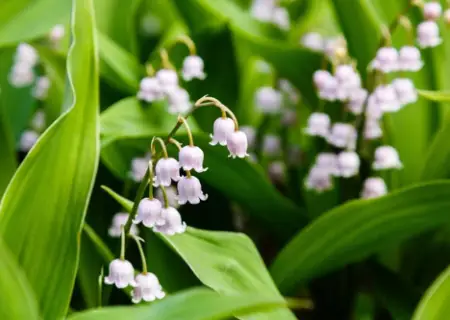
With their delicate, fragrant white blossoms shaped like bells, Lily of the Valley flowers gracefully dangle from long stalks. The plant is poisonous to humans and pets alike, despite its attraction. Their aggressive spreading habit also makes containment or division necessary to keep them from taking over the garden or overshadowing other plants.
Growing in USDA Growing Zones 3-8, lily of the valleys prefer soil that drains well and partial or full shade. When fully grown, it can reach a mature size of 6 to 12 inches. It is also resistant to deer, which makes it a desirable option for gardens looking for aesthetically striking, low-maintenance plants.
12. Creeping Phlox (Phlox stolonifera)
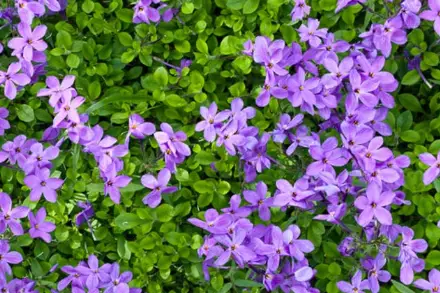
Phlox comes in a range of sizes, with low-spreading, creeping, and tall garden varieties all having persistent clusters of tiny flowers that bloom from the first frost until early spring. They prefer nutrient-rich, well-drained soil and grow well in either full or partial sun. Deadheading promotes more blooms, and pollinators, hummingbirds, and bees are drawn to their vivid blooms.
Phlox grows 6–12 inches tall and is suited to USDA Growing Zones 5–9. It is available in purple, pink, and white variants. They are a low-maintenance choice for gardeners seeking vibrant flowers and heightened pollinator activity because they are resistant to deer.
13. Pansy (Viola x wittrockiana)

The characteristic face-like center markings of Pansies, also known as Viola x wittrockiana, give them a lively charm. Though some may cascade, they often remain little. While they suffer with the intense summer heat, flowers can be encouraged to blossom again by pulling fading ones; shade and proper watering can aid. Their preferred conditions include full or partial light, well-drained soil, and spring and fall seasons.
Pansies are a versatile plant that grow to a mature height of 4 to 8 inches. They are suited for USDA Growing Zones 4 through 8. They are visually arresting, especially in the winter, but they are not resistant to deer.
14. Dianthus (Dianthus spp.)

Dianthus, popularly called “pinks,” is prized for its pinking shear-like fringed flower petals. These easy-care flowers have a wonderful clove-like aroma and long-lasting blooms. Their garden beauty is enhanced by the fact that they attract hummingbirds, bees, and other pollinators, and their possibilities range from hardy annuals to perennials.
Dianthus is a plant that grows best in USDA Growing Zones 3–9. It is available in a variety of colors, such as pink, purple, white, yellow, red, and bicolored varieties. They usually grow to a height of 6 to 36 inches, and they thrive in full sun and well-drained soil. Furthermore, they are a dependable and eye-catching option for any garden due to their resistance to deer.
15. Thyme (Thymus vulgaris)
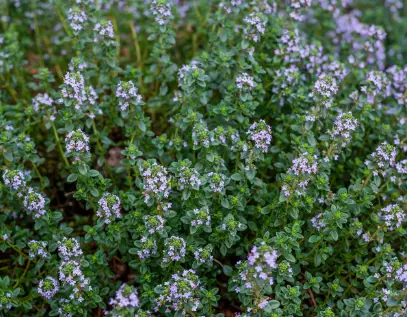
Thyme is a multipurpose plant that looks good in any garden and can be used as a culinary herb as well as a ground cover. Varieties such as ‘Italian Oregano’ have clumped leaves on thin stalks that carry into the fall and add a savory flavor to soups and veggies. Thyme thrives in full sun and well-drained soil; after the first spring blooms, prune the plants to encourage the reemergence of bright purple blossoms that draw native bees and helpful wasps.
Thyme grows to a height of 2 to 6 inches, making it ideal for USDA Growing Zones 2 to 10. It’s a great option to add color and functionality to a variety of garden arrangements because of its attractive purple color and deer resistance.
16. Sweet Alyssum (Lobularia maritima)
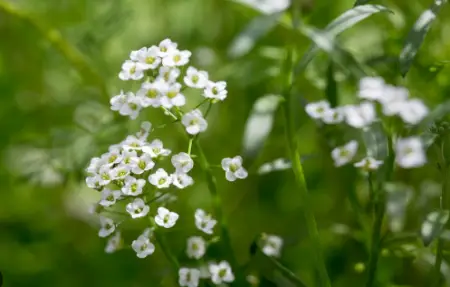
Loved for its scent of honey, Sweet Alyssum is readily available at garden centers in the early spring and grows from a variety of seeds that result in a rainbow of colorful Easter egg-colored flowers. Transplants do well in the cool spring temperatures, but some seeds germinate so quickly that they grow in less than a week. When the plant’s blooming becomes sparse, prune it to preserve its vigorousness.
Sweet alyssum blooms in several hues such as pink, orange, white, yellow, and red, and is suitable for USDA Growing Zones 7 through 11. Although it prefers rich, loamy soil with a neutral pH, it can grow in both full and partial sun. It is a good option for gardens in many areas because it is typically 3 to 10 inches tall and resistant to deer.
17. Snow-In-Summer (Cerastium tomentosum)

Cerastium tomentosum, the technical name for Snow-in-Summer, is a hardy perennial with eye-catching silver foliage and an abundance of white blooms. Because of its versatility, it can be used as a suitable filler for garden cracks and pavers as well as an eye-catching border accent. This plant, which thrives in full sun and soils that drain quickly, is ideal for rock gardens, especially in zones three through seven.
Snow-in-summer grows to a mature height of 6 to 12 inches, and its resistance to deer further adds to its allure in a variety of garden settings.
18. Rock Cress (Arabis)
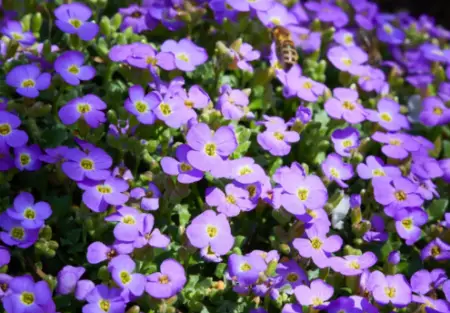
Arabis, sometimes referred to as Rock Cress, provides aficionados with over a dozen hybrid choices, one of which is the eye-catching ‘Axcent Lilac,’ with its vivid purple color. The evergreen foliage is covered with many 2 to 4-inch plants bearing pink, purple, or blue flowers in mid- to late-spring. After blooming, pruning the plants keeps their compact, mounding form and improves their appearance.
Rock cress is suited for USDA Growing Zones 4 through 7, where it prefers full sun exposure and well-drained, slightly acidic soil for optimum development. Usually growing to a mature height of 4 to 9 inches, this plant is also well-known for withstanding deer, which makes it a great addition to gardens across a variety of climates.
19. Lobelia (Lobelia erinus)
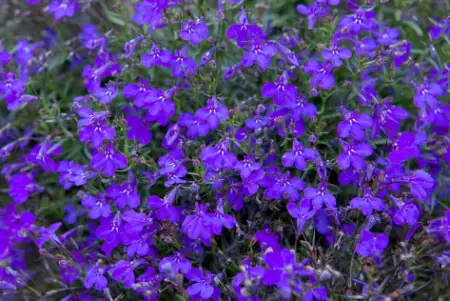
With its striking true-blue flowers, Lobelia, formally known as Lobelia erinus, is a favorite filler plant for early spring pots and hanging baskets. These blossoms have been introduced in new types that keep their color through the warmer months. Shearing the plant and making sure it is well-hydrated are good ways to promote a rebloom on warm evenings.
USDA Growing Zones 6 through 8 are ideal for Lobelia growth, which is best achieved in full sun and well-drained soil. This plant, which usually reaches a mature height of 6 to 9 inches, is also well-known for being resistant to deer, which adds appeal and dependability to it in a variety of garden settings.
20. Kenilworth Ivy (Cymbalaria muralis)
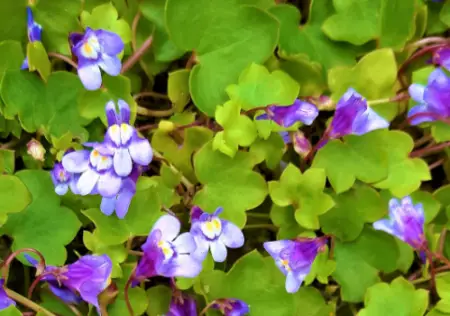
Kenilworth ivy, sometimes referred to as ivy-leaved toadflax or Cymbalaria muralis in science, is prized for its charming scalloped leaf that gives landscapes a unique texture even when the lavender flowers aren’t in bloom. But normally this plant blooms all spring and fall, especially in damp soils that receive some afternoon shade. It frequently self-seeds in colder climates, even though it is only hardy in zones 6 and higher.
USDA Growing Zones 6 through 11 are no match for Kenilworth Ivy, which prefers constantly moist soil and some sun exposure to flourish. At 2 to 3 inches in maturity, this plant is also noted for its ability to withstand deer, which makes it a hardy and attractive option for a variety of garden environments.
21. Forget-Me-Not (Myosotis)
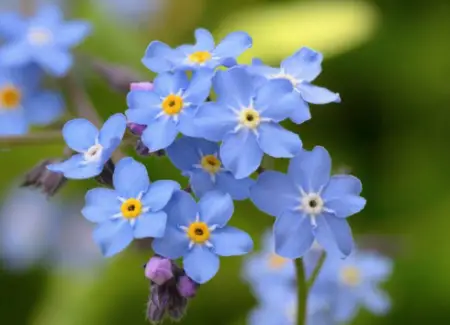
Myosotis, often known as Forget-Me-Not, is a great plant for forest gardens since it is visually pleasing and resistant to deer and rabbits. This is a low-maintenance, short-lived perennial that blooms bright blue in April and May with cheery yellow eyes that rapidly self-seed. Color-wise, Forget-Me-Not is compatible with USDA Growing Zones 3 through 8. It is available in blue, white, pink, and yellow. It grows to a mature size of one foot in height and width and thrives in both full and partial sun. It also prefers moist, well-drained soil.
22. Fairy Foxglove (Erinus alpinus)
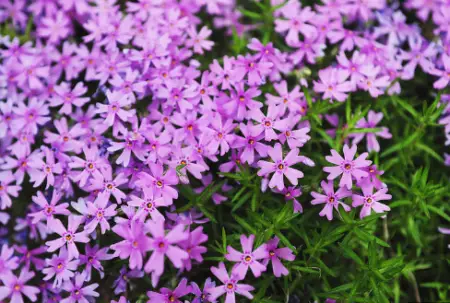
Fairy Foxglove is distinguished by its delicate, feather-like petals and dark green stems. It is sometimes referred to as starflower or alpine blossom. Although seeds can be grown, it’s easier to start with a mature plant from a nursery. Unlike many other plants found in rock gardens, these lovely blooms grow in any crack or cleft in the rock. They can also withstand some shade, which gives you options when it comes to location.
Fairy Foxglove grows in USDA Growing Zones 4 through 7. It is available in pink, purple, and white hues. It grows to a mature height of two to three inches and can withstand any kind of soil. Its resistance to deer makes it an appealing and low-maintenance option for gardens in various locations.
23. Baby’s Breath (Gypsophila)
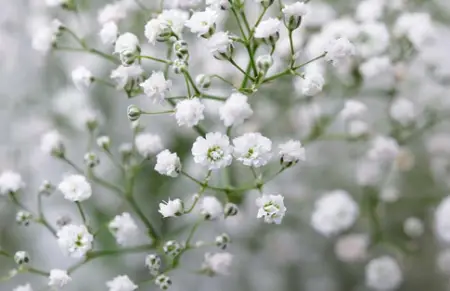
Gypsophila, also known as “baby’s breath,” is a hardy perennial that’s frequently used as a filler to bouquets for Valentine’s Day. Its fragile appearance belies its hardiness; it thrives in a variety of environments, especially in dry, medium soil and alkaline conditions, which makes it a good choice for rock gardens. Reliability in blooming dates for the ‘Bristol Fairy’ variety are April to late summer.
Baby’s Breath is available in a variety of hues, including white, pink, orange, red, yellow, and purple, and is suitable for USDA Growing Zones 4 through 9. Growing to a height of two to three feet, it prefers full sun exposure and alkaline soil. It is also deer-resistant, which makes it a trustworthy and attractive addition to gardens that are looking for both elegance and toughness.
24. Impatiens

Impatiens, known for their vivid blooms, are tropical perennials that are often considered annuals in many areas. They are perfect for partially to fully shaded garden spaces because they grow to an average height of 12 inches. moderate cultivators, such as the SunPatiens line, can tolerate moderate sun exposure, but they still require moist, well-drained soil.
Since impatiens love warmer climates, avoid growing them too early in the spring. Their vivid blossoms may fade or burn if they are exposed to too much sunshine. They’re normally only around for one growing season in most places, and they’re cold hardy in USDA Zones 10 and 11. Winter storage of impatiens, however, may be possible for committed gardeners with the right care.
25. Grape Hyacinth (Muscari spp)
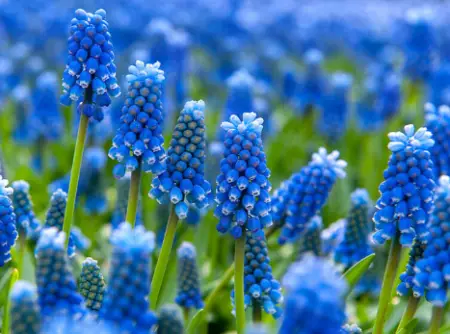
The bulb plant known as Grape Hyacinth is 6–9 inches tall and prefers full to partial light. It is not a true hyacinth, despite its name, but it looks like one with pretty purple flowers on thin stalks. It looks better when planted in clusters, and it can also be cultivated under deciduous trees in the flowering season before the leaves fully emerge.
Conclusion
The addition of small flowers can bring a delightful touch to any garden, adding bursts of color and texture to various landscapes. Whether you’re aiming to create vibrant borders, elegant container arrangements, or vibrant ground covers, the diverse array of small flowers mentioned in this guide offers a plethora of options for all types of gardeners. From resilient annuals to delicate perennials, these flowers not only enhance the visual appeal of your garden but also provide an opportunity to cultivate a vibrant and thriving outdoor space. Experiment with different combinations and arrangements to create a garden that reflects your unique style and preferences, making your outdoor haven a beautiful and inviting retreat.
People Who Read This Also Read:






